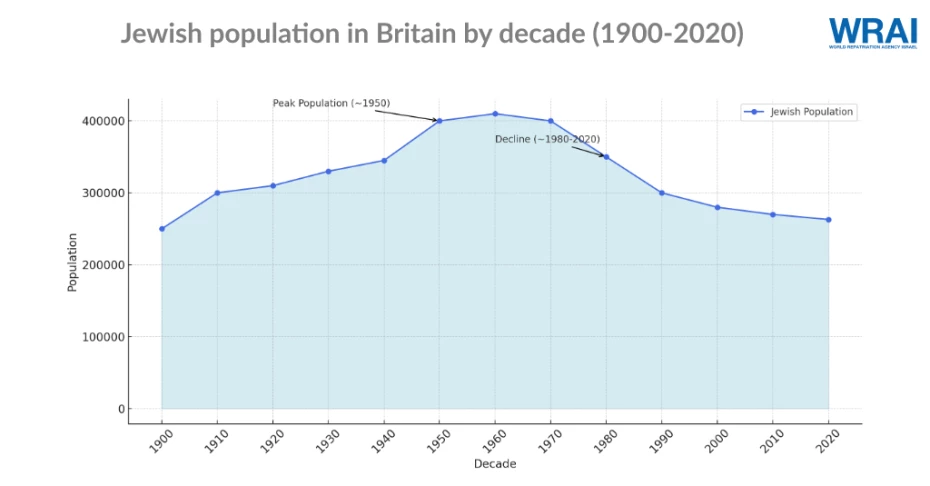Jewish population in the UK
UK is known for being developed and prosperous, as well as being a very multicultural place. After all, London itself is often described as a “mixing pot.” So it’s no surprise that there are many Jewish people here.
How many and where exactly? We’ll tell you in this article.
an Israeli citizenship specialist
How many Jews live in the UK
The most truthful answer will depend on how to measure.
However, if we do include those who were simply born to Jews here, in the UK, there are almost 350,000 of them. It really depends on how you measure it. If we’re talking about the core population, which is basically those who have proper hereditary roots and profess Judaism, there are about 300,000 of them. However, if we do include those who were simply born to Jews in the UK, there are almost 350,000 of them. This is out of 67.5 million people who, as a rough guide, live in the UK. Which is, to note, the fifth-largest Jewish community in the world. By percentage.
Current population statistics (as of 2024)
By far the largest number of Jews live in England:
| Country | Jewish Population | Key Features |
|---|---|---|
| England | ~260,000 | Home to the vast majority of British Jews, concentrated in Greater London, Manchester, Gateshead, and Leeds. |
| Scotland | ~6,000 | Primarily based in Glasgow (Giffnock and Newton Mearns), with smaller communities in Edinburgh and Dundee. |
| Wales | ~2,000 | Small communities in Cardiff, Swansea, and Bangor. Cardiff hosts the largest Jewish population in Wales. |
| Northern Ireland | ~300 | A very small Jewish population, mainly in Belfast, with a historic synagogue and community center. |
England is home to the vast majority, with approximately 260,000 Jews concentrated in major hubs like London, Manchester, and Leeds. Scotland hosts around 6,000 Jews, primarily in Glasgow. Wales has a smaller Jewish community of about 2,000, centered in Cardiff and Swansea. Northern Ireland has the smallest population, with approximately 300 Jews residing mainly in Belfast. These figures reflect the historical and cultural development of Jewish communities throughout the UK.
Population in London
Just to be totally accurate, 53.6% of people who identify as Jewish live in London. That’s the majority, when one look at the numbers. With so many Jews living here, it makes sense to talk about where the largest communities are based. Here are the most significant examples:
| City | Jewish Population | ||
|---|---|---|---|
| 1 | London | ~195,000 | Home to the largest Jewish community in the UK. Primarily concentrated in areas like Golders Green, Hendon, and Stamford Hill. |
| 2 | Manchester | ~30,000 | Significant Jewish population, particularly in Salford, Prestwich, and Bury. |
| 3 | Gateshead | ~8,000 | Known for its Orthodox Jewish community and prominent yeshivas. |
| 4 | Leeds | ~6,000 | Historically significant Jewish presence, centered around Moortown and Alwoodley. |
| 5 | Birmingham | ~2,500 | Vibrant community with synagogues and schools. Concentrated in Edgbaston and surrounding areas. |
| 6 | Glasgow | ~2,000 | Scottish city with a long-standing Jewish community, mostly in Giffnock and Newton Mearns. |
| 7 | Brighton & Hove | ~1,800 | Coastal city with a diverse Jewish population and a long history of Jewish settlement. |
| 8 | Bournemouth | ~1,500 | Popular retirement destination with a smaller but active Jewish community. |
| 9 | Liverpool | ~1,500 | Once home to one of the UK’s largest Jewish communities, now smaller but still active. |
| 10 | Southend-on-Sea | ~1,000 | A small but close-knit Jewish community in this Essex coastal town. |
Stamford Hill
This area in central London is home to the largest concentration of Hasidics in Europe, with around 17,000 residents. It’s not uncommon to see local men in traditional dress strolling to religious services. Also, there is one distinctive feature of the area – everything here is quite strict with rules and customs. In fact, in 2015 some local schools even got rid of English as a subject, removing it from the curriculum. However, it was reinstated later on.
New West End
The local synagogue is the heart of the Semitic community in the New West End. It’s been up and running since 1879, and it’s been a welcoming place for all Jews living in London ever since. In addition to the traditional Friday night services with choir singing, it also offers Hebrew classes for children and adults, as well as special fitness classes for women who have gone through childbirth.
Spitalfields
Not far from London’s former defense wall is an historic landmark – the Sandys Row Synagogue – built by French Huguenot refugees back in 1766. It was originally just a community church, which passed from Baptist to Salem Chapel, until in the mid-19th century the building was purchased by the Semitic society called “Hevrat Menahem Avalim Hesed v’Emeth” (The Comforters of Mourners Kindness and Truth Society, that is)
Yet it’s still quite impressive: we’re talking about several thousand people. Prayers can often be heard here, as well as Jewish festivals and even tours of a building with such a rich history.
Population in England
It should be noted at once that British Jews are overwhelmingly English-type people and identify themselves as such, so accurate counts are sometimes problematic. Be that as it may, there are only about six thousand Jews in Scotland, about two thousand in Wales, and less than 400 in Northern Ireland. Most of them are concentrated in the major cities like London, Manchester, and Glasgow.
Smaller communities also exist throughout the country. They can be found pretty much everywhere. By far the largest number of Jews live in and around London. Or the surrounding areas. The totals are as follows (approximate):
- Barnet – 56,000
- Hartsmere – 18,000
- Hackney – 17,000
- Bury – 10,000
- Salford – 10,000
- Camden – 10,000
- Haringey – 9,000
- Harrow – 7,000
- Redbridge – 6,000
- Leeds – 6,000
Demographics and distribution of British Jews
British Jews are full-fledged citizens, yet with corresponding origin. Most of them stay in the UK, but some move away. For instance, there’s always been a bit of a trickle to France and, of course, to Israel. Back in 2018, 530~ British people have relocated to Israel, marking the third consecutive annual decline. The trend is basically the same even now – It’s neither getting better nor worse.
Anyways, since 1948 about 26,000 Anglo-Jewry people have emigrated to Israel. Jewish population in Britain over the past 120 years. The population peaked around 1950, reaching approximately 400,000, driven by migration and post-war resettlement. However, subsequent decades saw a steady decline, influenced by emigration, assimilation, and demographic changes. As of 2020, the Jewish population in Britain is estimated to be around 263,000. The graph provides a visual representation of these shifts, reflecting key historical and societal impacts on the community.
Historical population trends
The latest figures show a steady rise in the UK’s Jewish population as of 2024. It’s not like it’s skyrocketing, but it is definitely growing. Recent studies also have even confirmed this is a trend. For instance, the census data from 2021 shows that the number in this area has increased by 2.4% ever since 2011.
There is the Board of Deputies, which has been around for over two hundred years. It’s a representative organization, and it’s there to represent the interests of Jews before the government. This organization brings together members of different synagogues and places across the religious spectrum – from ultra-orthodox to a modern ones.
Also, it’s worth noting how Jewry communities in Britain approach cultural and educational issues. They do it with genuine commitment and interest. There are more than 100 Jewish schools across the country, educating both children and teenagers from 5 to 17 years old.
In terms of religion, there are more than 350 synagogues, representing various streams of Orthodox, Reform, and Sephardic Judaism. It’s worth mentioning that the local community is pretty diverse when it comes to religious practices, even though the traditional Orthodox movement is still the dominant force. It makes up between 15% and 20% of the followers here. The most rough estimates put it at, at least. Meanwhile, Haredi makes up only 2-4%.
Jews were subjected to a lot of persecution and repression. For instance, just before the Edict of Expulsion, usury was allowed to Christians.
It was in the year of 1260. The Yiddish people were unable to resist the new competitive environment, and soon lost all their livelihoods. Since the 1660s, though, the government has started to get a reputation for religious tolerance, so it was only a matter of time before the Semitic community started to grow here. And things are even better now.
London is also home to the Union of Orthodox Hebrew Congregations, which was founded almost 100 years ago (98 years ago, to be exact) with the goal of protecting traditional Judaism values. It oversees all Orthodox rabbinical groups and is the umbrella organization for over a hundred synagogues and educational institutions across the country.
Overall, unlike many other countries with massive Semitic communities, the number of Jews in England is on the rise. Sure do, it’s pretty illiquid to compare it to the US, but as it happens historically, America has been an ark and haven for a huge number of people of this or that background. The possible “secret of the constant population growth” can be that while the average English family has one or two kids, that same average Orthodox family has five or even six.
an Israeli citizenship specialist

